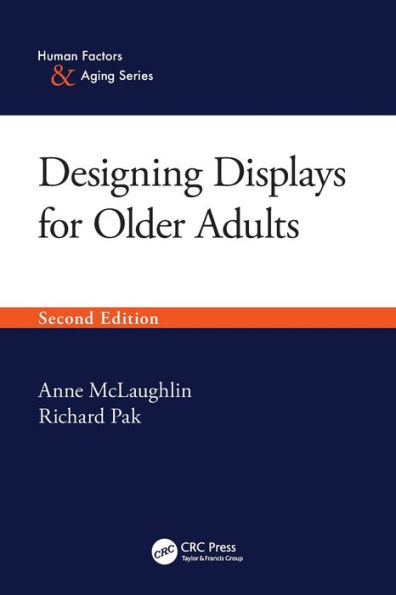Table of Contents
Preface xi
Authors xiii
Chapter 1 Introduction 1
1.1 Demographics and health trends 1
1.2 How older adults use technology now 3
1.3 State of the art and what the next 10 years will bring 4
1.3.1 Self-driving cars 5
1.3.2 Digital realities 6
1.3.3 Robots 6
1.3.4 Artificial intelligence 7
1.4 Mission statement 7
Suggested readings and references 8
Chapter 2 Vision 9
2.1 How vision changes with age 9
2.1.1 Visual acuity 11
2.1.2 Contrast sensitivity 13
2.1.3 Pathological conditions 14
2.1.4 Visual search 17
2.2 Interim summary 19
2.3 Display technologies 19
2.4 In practice: Presenting web information on a mobile device 23
2.4.1 Presentation of type 23
2.4.2 Organizing information on a mobile display 25
2.5 General design guidelines 30
Suggested readings and references 32
Chapter 3 Hearing 33
3.1 Hearing loss 34
3.1.1 Pitch perception 35
3.1.2 Loudness 35
3.1.3 Sound localization 38
3.1.4 Sound compression 39
3.1.5 Mp3s, cell phones, and other compressed audio 39
3.1.6 Background noise 39
3.2 Interim summary 40
3.3 Accessibility aids 40
3.3.1 Hearing aids 40
3.3.2 Telephony services and amplified technology 43
3.4 Interim summary 43
3.5 Human language 44
3.5.1 Prosody 46
3.5.2 Speech rate 47
3.5.3 Environmental support 47
3.6 Interim summary 47
3.7 Designing audio displays 48
3.7.1 Voice 48
3.7.2 Context 49
3.7.3 Passive voice 50
3.7.4 Prompts 50
3.7.5 Number and order of options 51
3.7.6 Alerts 51
3.8 In practice: The interactive auditory interface 51
3.9 General design guidelines 53
Suggested readings and references 54
Chapter 4 Cognition 57
4.1 How cognition changes with age 57
4.1.1 Fluid abilities 58
4.1.1.1 Perceptual speed 58
4.1.1.2 Working memory capacity 60
4.1.1.3 Attention 64
4.1.1.4 Reasoning ability 66
4.1.1.5 Spatial ability 68
4.1.1.6 Interim summary of fluid abilities 70
4.1.2 Crystallized knowledge 70
4.1.2.1 Verbal ability 70
4.1.2.2 Knowledge and experience 71
4.1.2.3 Mental models 72
4.1.2.4 Interim summary of crystallized intelligence 77
4.2 In practice: Organization of information 77
4.2.1 Page navigation vs. browser navigation 78
4.2.2 Previous knowledge and browsing/searching for information 80
4.3 General design guidelines 84
Suggested readings and references 85
Chapter 5 Movement 87
5.1 How movement changes with age 87
5.1.1 Response time 88
5.1.2 Accuracy 88
5.1.2.1 Increasing accuracy 90
5.1.3 Modeling response time and accuracy 92
5.2 Interim summary 95
5.3 Movement disorders 95
5.3.1 Parkinson's disease 95
5.3.2 Arthritis 96
5.4 Accessibility aids for movement control 97
5.4.1 Feedback 98
5.4.1.1 Tactile feedback 98
5.4.1.2 Auditory feedback 99
5.5 Interim summary 99
5.6 In practice: Display gestures 103
5.7 General design guidelines 103
Suggested readings and references 105
Chapter 6 Older Adults in the User-Centered Design Process 107
6.1 How testing older users is different 107
6.2 Requirements gathering 108
6.2.1 Age-sensitive user profiles and personas 109
6.2.1.1 Technological demographics and attitudes toward technology 112
6.2.1.2 Physiological attributes 112
6.2.2 Task analysis 113
6.2.3 Surveys 113
6.2.4 Focus groups 113
6.2.5 Interviews 115
6.2.6 Observation studies 115
6.3 Evaluation/inspection 115
6.3.1 Heuristic evaluations 116
6.4 Designing/prototyping/implementing alternate designs 116
6.4.1 Paper mock-ups/prototyping 119
6.4.1.1 Representative tasks 120
6.4.2 Simulating the effects of aging 121
6.5 Recruiting 121
6.6 Summary 123
Suggested readings and references 123
Chapter 7 Preface to Usability Evaluations and Redesigns 125
7.1 Organization of the redesign chapters 125
7.2 Displays chosen for evaluation and redesign 126
Chapter 8 Integrative Example: Smart Speakers 129
8.1 Overview 129
8.2 Step 1: Create a persona 129
8.2.1 Persona 130
8.3 Step 2: Define a task 132
8.4 Emergent themes 133
8.5 Tasks analysis of a smart speaker 134
8.5.1 Common issues 134
8.5.2 Positive design elements 135
8.6 Testing 140
8.7 Revised experience after redesign 140
Suggested readings 141
Chapter 9 Integrative Example: Workplace Communication Software 143
9.1 Overview 143
9.2 Step 1: Create a persona 144
9.2.1 Persona 145
9.3 Step 2: Task scenario 146
9.4 Emergent themes 148
9.5 Task analysis and heuristic evaluation of using chat-based collaboration software 149
9.5.1 Major categories of heuristic violations in workplace chat 149
9.6 Ideas for redesign of chat-based collaboration software 155
9.7 Summary 158
Suggested readings 158
Chapter 10 Integrative Example: Transportation and Ridesharing Technology 159
10.1 Overview 159
10.2 Step 1: Create a persona 160
10.3 Step 2: Define the task 162
10.4 Emergent themes 163
10.5 Task analysis 164
10.6 Heuristic evaluation 172
10.6.1 Expert evaluations 172
10.6.2 New heuristics 172
10.6.3 Heuristic violations 173
10.6.4 Heuristics specific to older adults 174
10.7 Discussion 176
Suggested readings and references 177
Chapter 11 Integrative Example: Mixed Reality Systems 179
11.1 Overview 179
11.2 Step 1: Create a persona 180
11.2.1 Persona 180
11.3 Step 2: Task scenario 183
11.4 Emergent themes for older adult users 184
11.5 Suggested development and testing methods 186
11.5.1 Recruitment of representative users 186
11.5.2 Participatory design with older users 186
11.5.3 Iterative designs 187
11.6 Usability testing 187
11.7 Speculative design 188
11.8 Conclusion and design recommendations 190
11.9 Summary 190
Suggested readings and references 191
Chapter 12 Conclusion 193
Index 197



